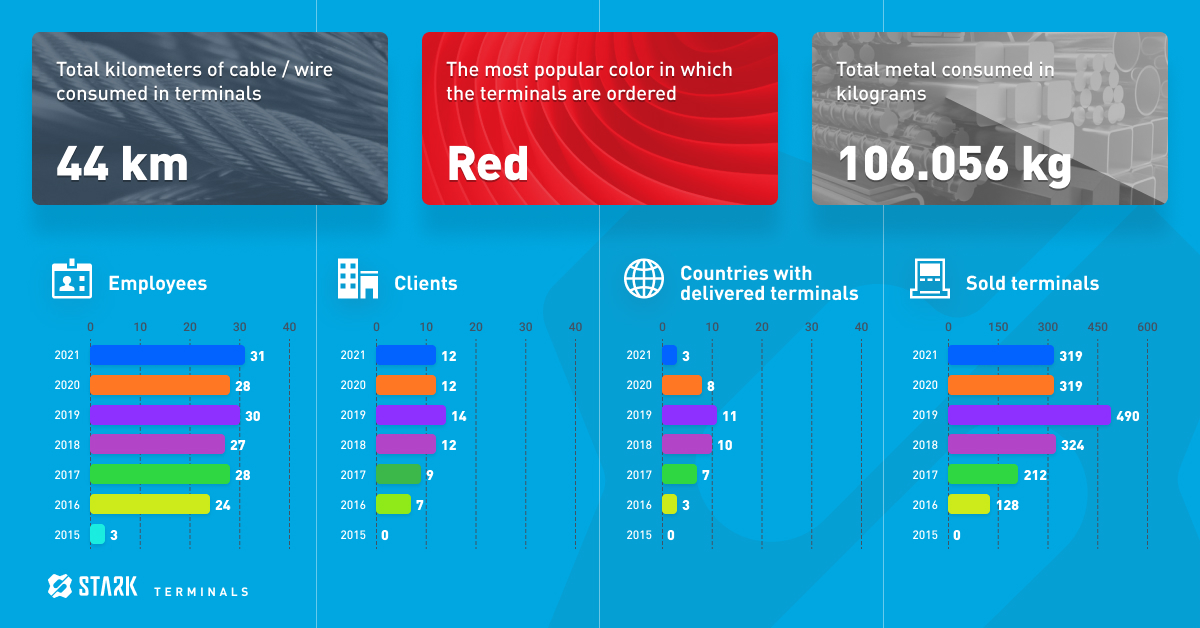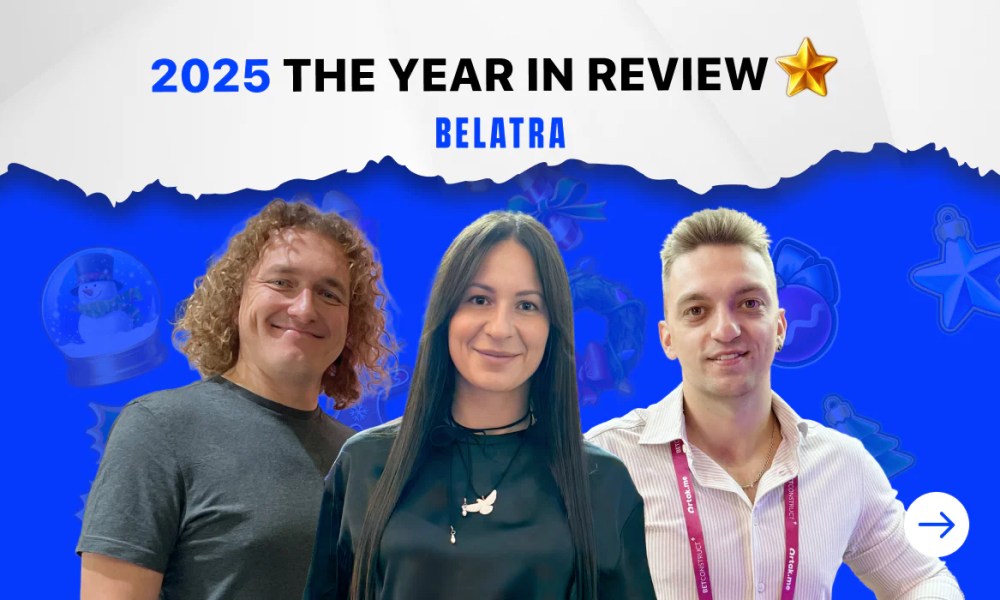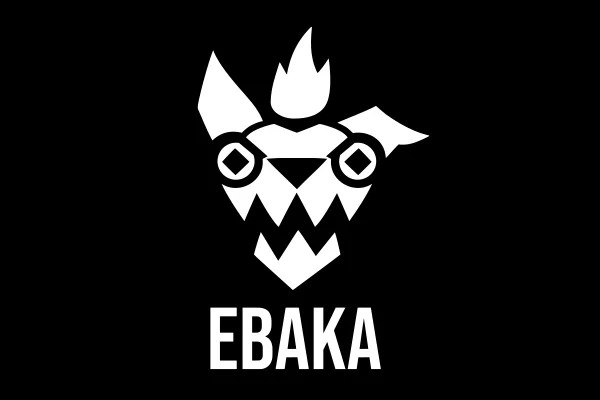Latest News
Stark Solutions celebrate 5 years of delivering exceptional SSBT’s

By Ivan Soče, Managing Director at Stark Solutions.
Once upon a time
Like many success stories, our story has started from the garage – to be precise, Stark’s story has started on the balcony.
At that time, Stark was an IT company developing software for betting terminals. Following the company owner’s idea, one of Stark’s employees manages to hand-build our first betting terminal at his balcony.
The rest is history. In the year 2015, the company produced its first terminal, the T-1000. We presented this model in the same year at the ICE London, iGaming and betting must-attend event.
The success story of top-performing terminals
It is important to emphasize that Stark Solutions is part of NSoft’s cluster, which gave it a good starting position from the very beginning. Stark’s first clients were already NSoft’s clients. They have recognized the potential and quality of Stark’s machines and used them for boosting their land-based business. The first clients were from our neighborhood, Montenegro and Serbia. After that, with the first clients from Western Europe, Stark’s expansion began.
At the moment, Stark terminals are entertaining punters on three continents. We are the exclusive suppliers for two Western European state lotteries and work with 30+ clients worldwide. All of this speaks in favour of the quality and highest standards by which our highly skilled welders, locksmiths, and machine engineers produce Stark betting terminals.
The development of the product offering was accompanied by global expansion, so currently, Stark has several models in its product portfolio.
The first model, the T-1000, has won the title of the best terminal on the market. Due to its modularity, customers can choose between three monitor variants and two body types. Separate spheres for money guarantee security and the modern design makes it aesthetically fit into any interior. The T-1000 has been exhibited twice at the prestigious G2E trade show in Las Vegas.
Following the market’s needs, Stark has produced the Wall-T, a terminal model with all the functionality of the T-1000 only in a smaller, three times lighter format. Exceptional technical characteristics, more accessible transport and space requirements, whether mounted on a wall, counter or bracket, make it extremely popular worldwide. Proof of this is the fact that Codere, Real Madrid’s official betting partner, has shown interest in Stark’s Wall-T terminal model and planned to equip their fun zone at the Santiago Bernabéu Stadium with them.
The Stark product range has been complemented by a premium model of the betting terminal called Atom. This model is made exclusively for casinos and hotels. With its flashy external appearance, chrome-plated parts and lights, it brings the world of betting closer to the world of slot games and casinos.
The latest in the Stark family of betting terminals is last year’s novelty, in many ways specific, the D1 desk terminal. We see its full potential in large bet shops, with live betting being the most prominent product. Combined with screens on which it is possible to watch matches live, D1 is an indispensable part of the branch because it allows the player to act faster to change during the game. The screen built into the table, with a hidden body, fits perfectly into any space.
SSBT’s are here to stay
Last year, when the retail business was hit hard due to the pandemic and when operators from the gambling and betting industries switched to online, it was to be expected that our company would suffer certain losses. We beat that odds! The year 2020 was the best year for Stark so far. Last year we capitalised on all our efforts made in the past five years. Tireless investment in quality, performance, appearance came to fruition in the most unexpected time.
In the spirit of the pandemic, the terminals have proven to be exceptionally epidemiologically safe. They can be placed to ensure social distance, and STARK’s betting terminals have screens that are touch-sensitive to latex gloves.
If we consider the fact that the terminals have taken precedence in retail, to reduce operating costs and increase the number of payment points in one branch, we can only say that we are sure that the terminals are here to stay.
Stark’s production capacities are extended to meet the deadlines with current orders and this is promising.
Customization and branding for clients satisfaction
In the past 5 years, we have tried to follow market trends and provide our clients with the best product. Following trends and understanding clients’ real needs has resulted in world-renowned machines.
Our terminals are equipped with parts from exclusively reputable manufacturers from MeiSC Advance bill acceptors to Advantech industrial PC. They are adapted to work on all known software, and built-in special devices leave the easy possibility of additional software upgrades.
In terms of branding, we allow our customers to choose the terminal colour according to their needs. Clients can personalize each terminal with a luminous logo. Depending on the size of the order, it takes 6 to 8 weeks from the day of signing the contract to the delivery of the finished products.

The infographic showcases the success story of Stark’s top-performing terminals for the last five years.
New opportunities and sales growth in the future
This year, judging by the period behind us, we expect further sales growth and an increase in the number of clients.
We will continue to strive to maximize our products by listening to the feedback we receive from customers. On the business side, we have been planning to enter new markets for some time now – a couple of European countries and the North American market. Regarding production, we plan to make a new model of a freestanding terminal.
We will do our best to continue Stark’s positive story for years to come.
Powered by WPeMatico
Belatra Games
From ‘Mummyverse’ to Crash Games: Belatra Reviews a Landmark 2025

Editor’s Take
Why this matters: Belatra has been a steady hand in the slots world for a long time, but 2025 marked a distinct shift in strategy. By entering the Crash vertical with Goose Boom Bang and winning big at SiGMA Africa, the studio is clearly pivoting to capture the high-growth, high-frequency players in emerging markets. They are no longer just a “classic slots” developer; they are diversifying the portfolio to ensure relevance in regions like LatAm and Africa.
The Full Story
Belatra Games, the specialist online slots developer, has issued a strategic review of its 2025 operations, celebrating a 12-month period defined by entry into new game verticals, significant franchise expansion, and high-profile industry recognition.
The year was characterized by a dual strategy: deepening engagement in established markets while aggressively expanding its content portfolio to suit local preferences in emerging territories.
Portfolio Evolution: Crash and Battles 2025 saw Belatra move beyond its traditional slot roots. The company made its debut in the high-demand Crash game vertical with the launch of Goose Boom Bang, a title designed to tap into the fast-paced gameplay preference of younger demographics.
Additionally, the studio introduced a fresh game concept with the launch of Battles, a new format unveiled for the first time in 2025, with further development planned for 2026.
The ‘Mummyverse’ Expands For fans of classic slots, the highlight of the year was the aggressive expansion of the Mummyverse. Belatra nearly doubled the size of this franchise over the year, making it the most extensive game universe in their entire catalog.
The developer also focused on B2B localization, releasing a number of exclusive bespoke games created specifically for selected operator partners to meet specific local market tastes.
Awards and Recognition The company’s strategic shifts were validated by industry accolades. Belatra secured over 30 nominations throughout the year, with standout wins including:
-
Best Slot Provider (awarded by BitStarz).
-
Most Played Game of 2025 for Make It Gold at the SiGMA Africa Awards.
-
Player’s Pick Award.
Management Commentary Misha Voinich, Head of Business Development at Belatra, commented on the studio’s momentum:
“This year has truly defined who we are as a studio – ambitious, creative and focused on building long-term partnerships. We’ve expanded our universes, launched new ones and entered exciting new markets that will all help us carry this momentum into the New Year.”
The post From ‘Mummyverse’ to Crash Games: Belatra Reviews a Landmark 2025 appeared first on Gaming and Gambling Industry Newsroom.
BMM Testlabs
‘Chaos and Soul’: Ebaka Games Plots Global Expansion After Viral Launch

Editor’s Take
Why this matters: The “Instant Game” vertical (Crash, Plinko, Mines) is becoming crowded, but Ebaka Games is cutting through the noise with a distinct brand personality. By securing BMM Testlabs certification so quickly after launch, they are signaling to Tier 1 operators that despite their “chaotic” marketing vibe, the math underneath is solid and compliant. The backing of industry veteran Dmitry Belianin also adds immediate commercial credibility to the startup.
The Full Story
Ebaka Games, the fledgling studio that promises to bring “chaos and soul” to the iGaming sector, has outlined an aggressive growth strategy for 2026 following a landmark launch period in late 2025.
The studio, which officially debuted in November, reports that its initial rollout reached more than five million people worldwide. The launch saw its portfolio go live with the operator Menace, serving as the initial testbed for its mechanics and “Ebaka modes.”
The Product: Instant Games with Personality Ebaka is bypassing traditional slots to focus on the high-growth vertical of fast-paced, instant-win games. Their initial lineup includes:
-
Plinko
-
Mines
-
Tower
-
Limbo
-
Crash
Differentiation is achieved through unique mascots and signature gameplay tweaks designed to offer high win potential and distinct visual identities, moving away from the generic interfaces often found in this genre.
Regulatory Milestone Crucially for its 2026 roadmap, Ebaka Games has confirmed it has secured certification from BMM Testlabs. This accreditation validates the fairness and integrity of its RNG (Random Number Generator) and game engines, removing a major barrier to entry for regulated markets. With this certification in hand, the studio plans to launch with a number of “major brands” in the coming year.
Management Commentary Vitalii Zalievskyi, CEO of Ebaka Games, commented on the studio’s unorthodox approach:
“It’s only been a few weeks since we first introduced Ebaka Games to the world. The feedback has been breathtaking, and it vindicates the decision for us to take a different path to the rest of the industry. You don’t need huge marketing budgets to grab people’s attention if you are building something truly innovative.”
Industry Backing The studio describes itself as being “created by players for players” but boasts significant industry firepower in its corner. The team includes Dmitry Belianin, a well-known figure in the sector who is the co-founder of Blask and Menace, as well as Managing Partner at Already Media.
The post ‘Chaos and Soul’: Ebaka Games Plots Global Expansion After Viral Launch appeared first on Gaming and Gambling Industry Newsroom.
ARC
Racing Meets Nightlife: SBK Backs ARC’s New ‘Friday Night Live’ Series

Editor’s Take
Why this matters: British racing has a well-documented demographic problem; its core audience is aging. “Friday Night Live” is a direct attempt to fix this by blending high-stakes racing with the “experience economy” (DJs, nightlife vibes) that appeals to Gen Z and Millennials. Bringing SBK on board—a mobile-first, app-only sportsbook—is a perfect demographic fit, while the Racing Post adds the necessary credibility to ensure the actual racing product remains the focus.
The Full Story
Arena Racing Company (ARC) has unveiled the strategic commercial lineup for its upcoming Friday Night Live series, confirming SBK as the Exclusive Betting Partner and The Racing Post as the Official Media Partner.
Set to launch in January 2026, Friday Night Live is a new initiative created in collaboration with youth-focused events company INVADES. The series is designed to overhaul the traditional race day experience, featuring fast-paced fixtures under floodlights, DJ sets, and significant entertainment elements sandwiched between races.
The Commercial Deal
-
SBK: As the exclusive betting partner, the Smarkets-owned sportsbook will take naming rights and on-course branding for all 35 races. Crucially, these races will be broadcast live on mainstream television via ITV Racing as well as Sky Sports Research.
-
The Racing Post: As the Official Media Partner, the publication will provide content, coverage, and promotion across its digital platforms, aiming to bridge the gap between established racing purists and the new audience ARC hopes to attract.
A High-Stakes Experiment The series is not just a marketing exercise; it carries serious sporting weight. Each of the five scheduled nights will feature over £200,000 in prize money. The fixtures will rotate across three of ARC’s all-weather tracks: Wolverhampton, Newcastle, and Southwell.
Management Commentary David Leyden Dunbar, Group Director of Commercial Strategy at ARC, was clear about the target audience:
“We have been very clear that one of the aims of Friday Night Live is to engage the next generation of racing fans… Both [partners] have shown real enthusiasm to work with us… as well as using the platform that these fixtures will offer them to also engage with more established racing and sports fans.”
Adam Baylis, Marketing Director at SBK, added:
“Friday Night Live [is] a fresh and engaging concept that brings a new energy to British racing. SBK has always been built around sport… our focus is on enhancing the live race day experience in a fun, social and responsible way.”
The 2026 Schedule The series kicks off immediately in the new year:
-
9th Jan: Wolverhampton
-
6th Feb: Newcastle
-
20th Feb: Southwell
-
20th March: Wolverhampton
-
27th March: Newcastle
The post Racing Meets Nightlife: SBK Backs ARC’s New ‘Friday Night Live’ Series appeared first on Gaming and Gambling Industry Newsroom.
-

 affiliate marketing6 days ago
affiliate marketing6 days agoSOFTSWISS 2025: 45% Game Portfolio Growth, LatAm Extensive Expansion and Flagship iGaming Trends Report
-

 B2B6 days ago
B2B6 days agoXpoint secures new growth funding to supercharge geolocation innovation for real money gaming
-

 Aviator6 days ago
Aviator6 days agoTKO: SPRIBE names UFC fighter Valter “The Clean Monster” Walker as Aviator brand ambassador
-

 Brand Activation6 days ago
Brand Activation6 days agoEsportes da Sorte strengthens brand presence during New Year’s Eve celebrations across four Brazilian capitals
-

 B2B6 days ago
B2B6 days agoHoli Primed For Emerging Markets Via New QTech Games Partnership
-

 B2B6 days ago
B2B6 days agoPlay’n GO games now live with Ivy Casino in the UK
-

 Alex Leese6 days ago
Alex Leese6 days agoPronet Gaming’s New Global Chapter Begins at ICE 2026
-

 BGaming4 days ago
BGaming4 days agoBGaming and Jon Vlogs Spread Christmas Joy with Charity Initiative



















